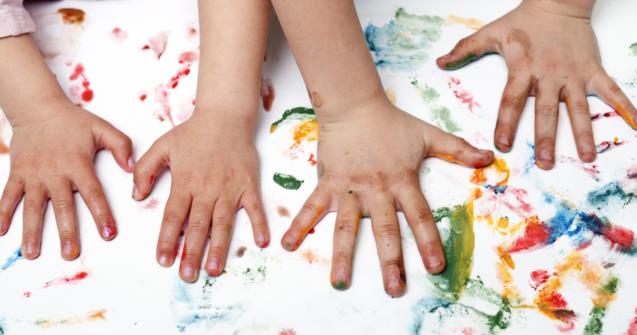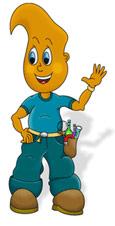
Globule wonders...
What can we use fingerprints for?
Experiment: Tracks
Hypotheses: Ask children where they have seen tracks or impressions (in sand, in snow, in windows, etc.). Ask them what had left the tracks (boots, feet, a finger, an animal's paw, an insect, etc.). Ask them how they were able to identify the culprit without having seen the person or animal.
Material:
- A sandy area where multiple tracks or impressions can be observed
(playground, schoolyard, etc.)
- A magnifying glass (optional)
Manipulations:
- Walk around the area your daycare worker selected. Watch your feet! Be careful not to erase already existing tracks.
- When you find a track, try to guess what could have left it (animal, adult, child, bicycle, etc.).
- After studying the entire area, have fun with your friends. Walk about the area leaving your own set of tracks.
- After a few minutes, your daycare worker will select a specific track. Play detective with your friends and try to determine who left it.
- Sit down to look at the soles of your friends' shoes to find the answer.
Experiment: Fingerprints
Hypotheses: Ask children if they know what fingerprints are. Ask them why and how fingerprints are used at crime scenes. One sheet of white paper per child, identified with their names and divided into 2 rows of 5 spaces each.
STAMP PAD
Manipulations:
- Look closely at the sheet of paper your daycare worker gave you. It is divided into two rows of five spaces, one to print each of your fingers. The top row will be for your left hand whereas the bottom row will be for your right hand (thumb, index, middle finger, ring finger, and little finger). This is a great time to review the names of your fingers.
- With your daycare worker's help, gently press your first finger onto the stamp pad.
- Place your finger in the first space and lightly touch the paper to leave a fingerprint.
- Repeat for each of your fingers.
- Can you spot two identical fingerprints on your paper? Isn't it surprising to see how different they all are?
- You can also look at your friends' papers. You all have unique fingerprints!
Explanations: Fingerprints are frequently used to indicate a person's presence in a particular location. Detectives use all possible traces to identify criminals and prove they were at a crime scene. However, only fingerprints can prove that a suspect is guilty. Two people can have the same shoes, but no two people have the same fingerprints. The tiny lines at the end of our fingers are unique. No one else in the world has the same ones as you! Using sophisticated instruments, policemen are able to collect fingerprints and find their owners.
Angélique Boissonneault
has a Bachelor's Degree in Biological Science. She has worked in a laboratory and tested her knowledge. She has taught Math, Chemistry, and Physics. She has also developed a simplistic and innovative approach designed to introduce young children to scientific experiments, old and new. She created her friend Globule. This character is sometimes red, and sometimes white. He guides little ones through their scientific experiments and discoveries. It is clear to see Angélique is passionate about children and science. Globule's Approach.

 Home
Home Theme activities
Theme activities
 Babies and toddlers
Babies and toddlers
 Arts and crafts
Arts and crafts
 Science
Science
 Creative recipes
Creative recipes
 Tips and tricks
Tips and tricks
 Special needs
Special needs
 Extra activities
Extra activities
 Educ-TV
Educ-TV
 Newsletter
Newsletter  Online store
Online store Educatall club
Educatall club

